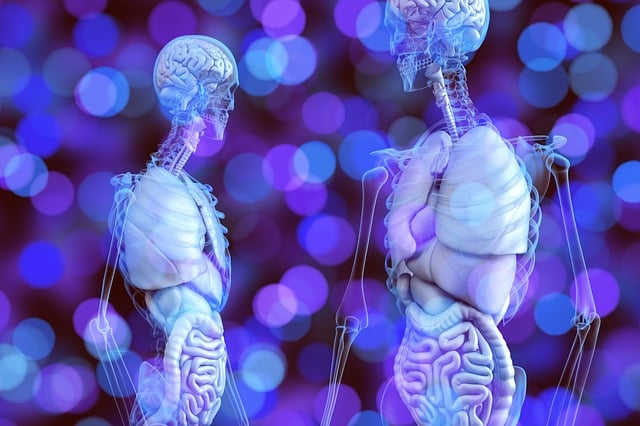The endocannabinoid system (ECS) is a fundamental component of human physiology responsible for maintaining bodily homeostasis and regulating a range of functions including pain perception, mood, appetite, and immune responses. This system, composed of endocannabinoids, cannabinoid receptors, and degrading enzymes, plays a crucial role in pain management, with research indicating its involvement in chronic pain conditions like fibromyalgia, migraines, and irritable bowel syndrome. Recent advancements are shedding light on the ECS's interactions, paving the way for targeted therapies that offer potential benefits with fewer side effects than conventional treatments. These developments include the exploration of cannabinoids, dietary changes, and mind-body practices as modulators of the ECS, aiming to provide personalized and holistic pain management strategies. Future research is set to enhance our understanding of the ECS's functions and its integration with other biological systems, promising to transform the field of pain treatment by harnessing the system's natural regulatory capabilities for superior patient outcomes.
Exploring the intricacies of pain modulation, this article sheds light on the pivotal role of the endocannabinoid system (ECS) in regulating discomfort. The ECS, a vast network of receptors and neurotransmitters, fine-tunes various bodily functions, including pain perception. By examining its components—cannabinoids, receptors, and enzymes—we gain insight into the ECS’s mechanisms and their impact on pain management. Investigating how dysfunction within this system can exacerbate chronic pain conditions opens a door to novel therapeutic interventions. This exploration concludes with future research directions aimed at optimizing pain modulation strategies, furthering our understanding of the endocannabinoid system’s potential in alleviating suffering.
Unveiling the Endocannabinoid System: A Fundamental Regulator of Pain Modulation

The intricate dance between pain signals and perception is orchestrated by a vital molecular system within the human body known as the Endocannabinoid System (ECS). This complex network plays a pivotal role in maintaining homeostasis, which includes modulating pain sensation. Comprised of endocannabinoids, receptors, and enzymes, the ECS is spread across various bodily systems, including the nervous and immune systems. The discovery of this system has significantly advanced our understanding of how it responds to both internal and external stimuli that provoke pain responses.
Researchers have identified two primary types of endocannabinoid receptors: CB1 and CB2. CB1 receptors are predominantly found in the central nervous system, while CB2 receptors are primarily located in peripheral organs, immune cells, and the brain. When a pain signal is detected, the ECS responds by releasing endocannabinoids, which bind to these receptors, reducing the perception of pain. This process is not merely a response to pain but actively participates in fine-tuning the body’s reaction to various painful conditions. By modulating neurotransmitter release in pain pathways, the ECS helps regulate inflammation and pain levels, offering insight into potential therapeutic targets for a multitude of pain-related disorders. Understanding the Endocannabinoid System is thus crucial for developing new approaches to treating chronic and acute pain conditions.
Components and Mechanisms of the Endocannabinoid System: Cannabinoids, Receptors, and Enzymes

The endocannabinoid system (ECS) is a complex cell-signaling system identified in the early 1990s, crucial for maintaining homeostasis, which is the balance of physiological processes within an organism. This intricate system consists of three core components: endocannabinoids, cannabinoid receptors, and enzymes that modulate their production and degradation.
Endocannabinoids are naturally occurring lipid-based retrograde neurotransmitters that bind to cannabinoid receptors with high affinity, triggering a variety of cellular reactions. The two primary endocannabinoids are anandamide and 2-arachidonoylglycerol (2-AG). Anandamide is often referred to as the “bliss molecule” due to its role in pleasurable and rewarding experiences, while 2-AG has a broader range of actions. These endocannabinoids play a significant role in pain modulation by influencing various physiological processes such as appetite, sleep, mood, memory, reproduction, and pain sensation.
Cannabinoid receptors are the binding sites for both endogenous cannabinoids and phytocannabinoids like those found in cannabis. There are two main types of cannabinoid receptors: CB1 and CB2. CB1 receptors are predominantly located in the brain and are responsible for the psychoactive effects of cannabinoids. They are involved in regulating pain, coordination, memory, emotion, appetite, and other functions. CB2 receptors are primarily found outside the nervous system, mostly on cells associated with the immune system and are thought to play a role in modulating inflammation and pain.
The synthesis and degradation of endocannabinoids are tightly regulated by a set of enzymes. Enzymes known as fatty acid amide hydrolase (FAAH) and monoacylglycerol lipase (MAGL) are responsible for the breakdown of anandamide and 2-AG, respectively. These enzymes ensure that endocannabinoids signal transiently, allowing for precise control over their effects. Understanding the ECS and its components is fundamental for elucidating how cannabinoids can influence pain perception and modulation, offering potential therapeutic applications for a variety of conditions.
The Role of the Endocannabinoid System in Pain Perception and Management

The endocannabinoid system (ECS) plays a pivotal role in modulating pain perception and management within the human body. This complex cell-signaling system, comprising endocannabinoids, receptors, and enzymes, is spread throughout various organs and tissues. Understanding the Endocannabinoid System is crucial for elucidating its profound effects on pain regulation. Endocannabinoids are naturally occurring compounds that bind to cannabinoid receptors, which are found in nearly every organ system in the body. Upon activation, these receptors can either reduce or increase the sensation of pain. The ECS’s influence extends beyond just pain; it also affects mood, memory, and even immune function. When disruptions occur within this intricate network, it can lead to dysregulation of pain responses, contributing to a variety of pain-related conditions. By modulating the release and degradation of endocannabinoids through pharmacological or therapeutic interventions, it is possible to fine-tune the body’s response to pain stimuli, offering potential avenues for treatment in both acute and chronic pain scenarios. This underscores the importance of research into how the ECS can be harnessed to improve the lives of individuals suffering from pain.
Endocannabinoid System Dysfunction and Its Impact on Pain Conditions

The endocannabinoid system (ECS) is a complex cell-signaling system identified in the early 1990s. It plays a pivotal role in regulating a range of physiological processes, including pain sensation and inflammation response. This intricate system is composed of three core components: endocannabinoids, receptors, and enzymes. Endocannabinoids are naturally occurring lipid-based retrograde neurotransmitters that bind to cannabinoid receptors. The two primary receptors, CB1 and CB2, are found throughout the body, with CB1 predominantly in the central nervous system and CB2 in peripheral organs, especially the immune system. Enzymes, such as fatty acid amide hydrolase (FAAH) and monoacylglycerol lipase (MAGL), break down endocannabinoids after they have performed their function.
Understanding the ECS is crucial for elucidating how it contributes to pain modulation. Dysfunction in the ECS can lead to a disruption in its normal regulatory functions, which may contribute to various pain conditions. For instance, an imbalance in endocannabinoid levels or malfunctioning receptors can result in heightened pain sensitivity, a condition known as clinical endocannabinoid deficiency (CECD). This dysregulation is believed to be associated with a host of chronic pain syndromes, including fibromyalgia, migraines, and irritable bowel syndrome. Research indicates that modulating the ECS through various means, such as cannabinoids found in cannabis or synthetic cannabinoid receptor agonists, holds promise for developing new therapeutic strategies to manage chronic pain conditions effectively. Thus, exploring the intricacies of the endocannabinoid system is essential for advancing our approach to pain management and improving the quality of life for those suffering from such disorders.
Therapeutic Interventions Targeting the Endocannabinoid System for Pain Relief

Understanding the endocannabinoid system (ECS) and its role in pain modulation has opened new avenues for therapeutic interventions targeting this complex network. The ECS is a fundamental component of human physiology, responsible for maintaining homeostasis, regulating mood, appetite, immune response, and, crucially, perceiving and responding to pain. Dysfunction within the ECS can lead to a host of pathologies, including chronic pain conditions. Recent advancements in research have highlighted the potential of the ECS as a target for pharmacological and non-pharmacological interventions aimed at alleviating pain.
Therapeutic strategies that modulate the ECS offer a promising alternative or adjunct to traditional pain management approaches. These include the use of cannabinoids, which can directly interact with the ECS receptors. Cannabidiol (CBD), a non-psychoactive component of cannabis, has been studied for its analgesic properties and ability to reduce inflammation and anxiety without the high associated with THC, another cannabinoid. Additionally, synthetic cannabinoids have been developed to more precisely target specific ECS receptors, offering an increased therapeutic window and reduced side effects. Other interventions such as dietary changes rich in omega-3 fatty acids, which are precursors to endocannabinoids, and mind-body practices like yoga and meditation, which may influence ECS function through stress reduction, also show potential in the management of pain. These therapeutic approaches offer a personalized and holistic method for pain relief by directly addressing the underlying mechanisms of pain perception and modulation through the endocannabinoid system.
Future Directions in Endocannabinoid System Research for Enhanced Pain Modulation Strategies

Research into the endocannabinoid system holds immense potential for advancing our capacity to modulate pain. As scientists continue to unravel the complexities of this biological framework, future directions in this field promise a deeper understanding of how endocannabinoids interact with receptors throughout the body. This knowledge is pivotal in developing targeted therapies that can effectively manage pain without the debilitating side effects often associated with current treatments. The integration of advanced imaging techniques and genomic analysis will likely play a significant role in this endeavor, enabling researchers to observe the endocannabinoid system’s dynamic responses in real-time and tailor interventions accordingly. Moreover, the exploration of novel cannabinoid receptor agonists and antagonists, as well as the investigation into the endocannabinoid system’s interactions with other biological systems, such as the immune and nervous systems, will be critical in refining pain modulation strategies. The ultimate goal is to harness the regulatory capabilities of the endocannabinoid system to achieve superior pain management outcomes, which could revolutionize the approach to treating chronic and acute pain conditions.
